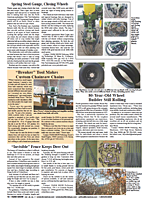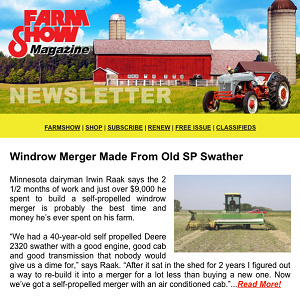Nebraska Researchers Want To Grow Crops On Mars
 ✖  |
Researchers at the University of Nebraska-Lincoln (UNL) are focusing on growing plants in space. The Space, Policy, Agriculture, Climate and Extreme Environment (SPACE2) project hopes to grow the first acre of corn or soybeans on Mars. It won’t be easy.
Challenges include everything from 38% less gravity—which affects water flow and planter downforce—to the planet’s surface conditions. Previous UNL research attempted to grow soybeans in imitation lunar surface materials. Known as regolith, the material is a mixture of rock fragments, dust and glass-fused minerals. Doctoral student Cassie Palmer found that the soybean seeds struggled to sprout and root. The lack of pores in the lunar “soil” caused it to solidify, preventing root caps from migrating and taking up nutrients.
A similar study involving Martian regolith was even less successful. The imitation Martian materials produced no growth at all.
Palmer noted that even if the Martian soil could support plant growth, high levels of perchlorate compounds would make them toxic. The compound destroys lymph nodes and thyroid glands.
She suggests introducing microbes to transform the perchlorates into oxygen, water and chloride ions.
The initiative, led by 28 UNL faculty and researchers, aims to address those and other issues. Yufeng Ge and Santosh Pitla head it up. Ge is a professor of biological systems engineering. Pitla is an associate professor of biological systems engineering. Ge has specialized in sensors, and Pitla spearheaded the engineering of Flex-Ro, an autonomous planter (Vol. 47, No. 5).
The consortium wants UNL to house the first center devoted to the study of agriculture in space. Pitla expects robotics to play a key role in the future of agriculture in space.
“Before humans go to Mars, we’ll want some essential resources there, and for that, we’ll send robots,” Pitla told Nebraska Today. “Think about a greenhouse on a spaceship that’s landed on Mars, and it’s already started growing food. You need a fully automated, robotic farmer that’s doing those things even before humans arrive.”
Other production systems, such as hydroponics and aeroponics, would be more likely to be the initial food production systems. Hassan Fazayeli is a Ph.D. student in biological engineering, exploring both indoor systems.
“We’re trying to resolve engineering challenges with indoor agriculture to support human activities in extreme environments,” says Fazayeli. “It’s even more important in space than on Earth to produce more output with fewer inputs.”
Ge admits that growing vegetables and greens that don’t require processing would be more energy efficient. However, he points out that corn and soybeans may still find a place, in part for their residual, long-term benefits.
“Yes, the first generation (of regolith) is really harsh for plants,” Ge told Nebraska Today. “But hopefully, when you keep adding the corn stalks, soybean residues or some of the waste coming from other processes, you can improve it to the point that you can actually reasonably grow the plants.”
The primary challenge faced by agriculture in space research is securing funding.
“We’re actively looking for support,” notes Fazayeli.
Contact: FARM SHOW Followup, Yufeng Ge, University of Nebraska-Lincoln, CHA 211, Lincoln, Neb. 68583 (ph 402-472-1413; yge2@unl.edu).

Click here to download page story appeared in.
Click here to read entire issue
Nebraska Researchers Want To Grow Crops On Mars
Researchers at the University of Nebraska-Lincoln (UNL) are focusing on growing plants in space. The Space, Policy, Agriculture, Climate and Extreme Environment (SPACE2) project hopes to grow the first acre of corn or soybeans on Mars. It won’t be easy.
Challenges include everything from 38% less gravity—which affects water flow and planter downforce—to the planet’s surface conditions. Previous UNL research attempted to grow soybeans in imitation lunar surface materials. Known as regolith, the material is a mixture of rock fragments, dust and glass-fused minerals. Doctoral student Cassie Palmer found that the soybean seeds struggled to sprout and root. The lack of pores in the lunar “soil” caused it to solidify, preventing root caps from migrating and taking up nutrients.
A similar study involving Martian regolith was even less successful. The imitation Martian materials produced no growth at all.
Palmer noted that even if the Martian soil could support plant growth, high levels of perchlorate compounds would make them toxic. The compound destroys lymph nodes and thyroid glands.
She suggests introducing microbes to transform the perchlorates into oxygen, water and chloride ions.
The initiative, led by 28 UNL faculty and researchers, aims to address those and other issues. Yufeng Ge and Santosh Pitla head it up. Ge is a professor of biological systems engineering. Pitla is an associate professor of biological systems engineering. Ge has specialized in sensors, and Pitla spearheaded the engineering of Flex-Ro, an autonomous planter (Vol. 47, No. 5).
The consortium wants UNL to house the first center devoted to the study of agriculture in space. Pitla expects robotics to play a key role in the future of agriculture in space.
“Before humans go to Mars, we’ll want some essential resources there, and for that, we’ll send robots,” Pitla told Nebraska Today. “Think about a greenhouse on a spaceship that’s landed on Mars, and it’s already started growing food. You need a fully automated, robotic farmer that’s doing those things even before humans arrive.”
Other production systems, such as hydroponics and aeroponics, would be more likely to be the initial food production systems. Hassan Fazayeli is a Ph.D. student in biological engineering, exploring both indoor systems.
“We’re trying to resolve engineering challenges with indoor agriculture to support human activities in extreme environments,” says Fazayeli. “It’s even more important in space than on Earth to produce more output with fewer inputs.”
Ge admits that growing vegetables and greens that don’t require processing would be more energy efficient. However, he points out that corn and soybeans may still find a place, in part for their residual, long-term benefits.
“Yes, the first generation (of regolith) is really harsh for plants,” Ge told Nebraska Today. “But hopefully, when you keep adding the corn stalks, soybean residues or some of the waste coming from other processes, you can improve it to the point that you can actually reasonably grow the plants.”
The primary challenge faced by agriculture in space research is securing funding.
“We’re actively looking for support,” notes Fazayeli.
Contact: FARM SHOW Followup, Yufeng Ge, University of Nebraska-Lincoln, CHA 211, Lincoln, Neb. 68583 (ph 402-472-1413; yge2@unl.edu).
To read the rest of this story, download this issue below or click
here to register with your account number.







